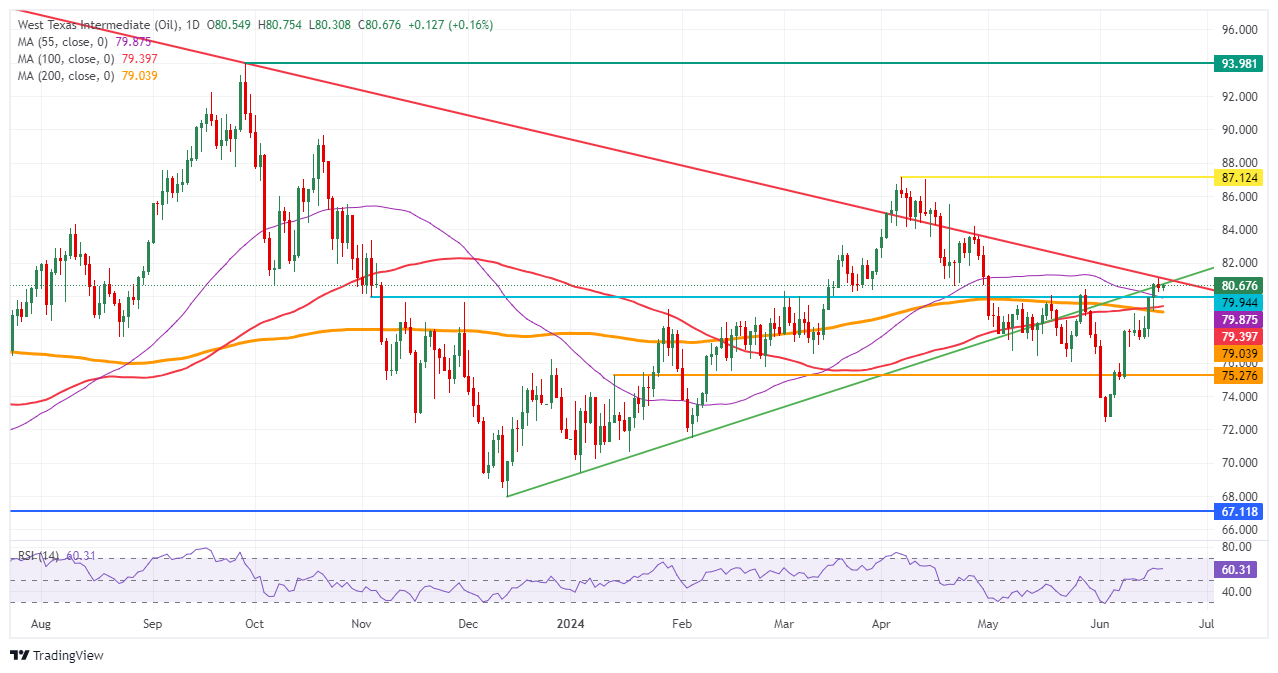- Oil remains above $80 on Thursday, marking another profitable week.
- Traders keep prices supported as tensions in the Middle East intensify.
- The DXY Dollar Index is trading again around 105.50 amid rising safe haven flows.
The price of oil is rising for the second week in a row and remains above $80 on Thursday after tensions in the Middle East rise again. On Tuesday, Israel approved plans to launch an offensive in Lebanon with the motivation of trying to eliminate Hezbollah. Meanwhile, a Greek cargo ship sank on Wednesday after Houthi rebels attacked it with a drone in the Red Sea.
Meanwhile, the DXY Dollar Index is trading again near 105.50 after easing earlier this week due to weak US retail sales data for May. The Dollar is gaining strength, however, on Thursday, as markets are concerned after the People’s Bank of China (PBoC) abandoned its overnight peg of the Yuan against the Dollar, opening the door to a devaluation against the US Dollar. Markets are interpreting this as a sign of concern about further PBoC easing and interventions.
At the time of writing, Crude Oil (WTI) is trading at $80.58 and Brent Crude is trading at $84.56.
Oil news and market drivers: Houthi rebels attack again
- Houthi rebels have sunk a Greek cargo ship in the Red Sea using an unmanned drone missile on Wednesday, Reuters reported.
- For the fourth consecutive month, China has imported nearly 284,000 tons of Venezuelan crude oil despite implicit US embargoes, Bloomberg reports.
- At 15:00 GMT, the change in US inventories for the week ending June 14 will be published by the Energy Information Administration (EIA). The previous release was an increase of 3.73 million barrels, with a reduction of 2 million expected this week.
- Tropical Storm Alberto is approaching the western Gulf Coast and could cause brief disruptions to the region’s crude oil supply.
Technical Analysis of the oil price: Brief bullish elements
The price of oil is rising due to a mix of data that leans towards the bullish side. With hurricane season starting in the US, Houthi rebels sinking a ship in the Red Sea, and Israel set to continue its military actions by entering Lebanon, operators have a variety of items to choose from, which is reason enough to increase oil prices. If the EIA release on Thursday shows another significant reduction, crude oil prices could jump to a new higher price range.
To the upside, the red descending trend line near $81.00 is the last remaining boundary before entering a new price region not seen since April. A break above the trendline would open room for a move back to $87.12, the year-to-date high (April 5). Previously, a relatively small pivot level would act as resistance near $84.00.
To the downside, the large belt of simple moving averages (SMA) should now function as support and no longer allow moves below it. That means the 55-day SMA at $79.87, the 100-day SMA at $79.39, and the 200-day SMA at $79.03 should no longer see declines below $79.00. If those levels do not hold, another drop back to $75 could be inevitable.
US WTI Crude Oil: Daily Chart
WTI oil
WTI oil is a type of crude oil that is sold in international markets. WTI stands for West Texas Intermediate, one of the three main types that include Brent and Dubai crude. WTI is also known as “light” and “sweet” for its relatively low gravity and sulfur content, respectively. It is considered a high-quality oil that is easily refined. It is sourced in the United States and distributed through the Cushing facility, considered “the pipeline junction of the world.” It is a benchmark for the oil market and the price of WTI is frequently quoted in the media.
Like all assets, supply and demand are the main factors that determine the price of WTI oil. As such, global growth can be a driver of increased demand and vice versa in the case of weak global growth. Political instability, wars and sanctions can alter supply and impact prices. The decisions of OPEC, a group of large oil-producing countries, is another key price factor. The value of the US Dollar influences the price of WTI crude oil, as oil is primarily traded in US dollars, so a weaker Dollar can make oil more affordable and vice versa.
Weekly oil inventory reports published by the American Petroleum Institute (API) and the Energy Information Agency (EIA) influence the price of WTI oil. Changes in inventories reflect the fluctuation of supply and demand. If the data shows a decline in inventories, it may indicate an increase in demand, which would drive up the price of oil. An increase in inventories can reflect an increase in supply, which drives down prices. The API report is published every Tuesday and the EIA report the next day. Their results are usually similar, with a difference of 1% between them 75% of the time. EIA data is considered more reliable since it is a government agency.
OPEC (Organization of the Petroleum Exporting Countries) is a group of 13 oil-producing nations that collectively decide member countries’ production quotas at biannual meetings. Their decisions often influence WTI oil prices. When OPEC decides to reduce quotas, it can restrict supply and drive up oil prices. When OPEC increases production, the opposite effect occurs. OPEC+ is an expanded group that includes ten other non-OPEC member countries, including Russia.
Source: Fx Street
I am Joshua Winder, a senior-level journalist and editor at World Stock Market. I specialize in covering news related to the stock market and economic trends. With more than 8 years of experience in this field, I have become an expert in financial reporting.








